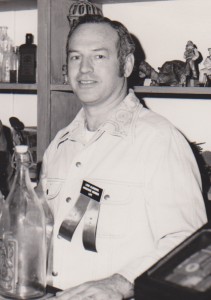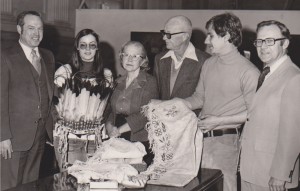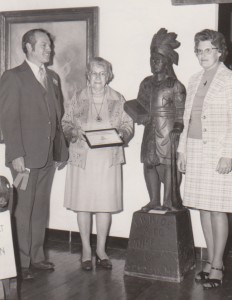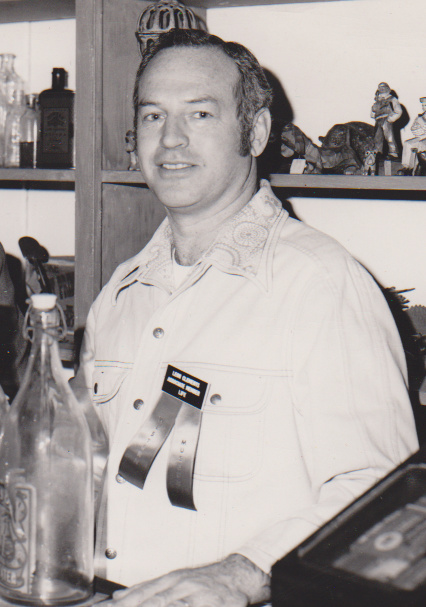By Marla Vizdal

The current Artifact of the Month at the Western Illinois Museum highlights its collection of oral history tapes, and one in particular stands out this month. That particular recording was the one done with Leon Clements, regarding the history of the Student University Museum, now Western Illinois Museum. Unfortunately, as this article was being written with this recording in mind, the man giving the interview, Leon Clements, passed away on March 15, 2016, at the age of 83. His recollections of the facts regarding the history of the museum and how it came to be where it is today, are an important part of the historical documentation of the museum. They also convey how instrumental he was in its formation and vision, as well as his long-time dedication to the museum.
But, what is an oral history? According to one source, it is a systematic collection of a person’s memories and a testimony of their own experiences. It is a way of permanently preserving the history, stories, and folklore of a person or a generation. Each type of oral history has a valid focus. Historical oral histories normally document facts, while story telling relates memories and tales, which are not necessarily based on historical fact. Oral histories of folklore help to document the stories and customs of a group or population that have been passed down from generation to generation, and most likely don’t appear in a textbook or published history. All three of these have valid purposes, but the type best represented at the Western Illinois Museum are the historical oral histories.
An oral history is a recording of a dialogue between an interviewer and the subject(s) of the interview. These interviews, which were once recorded on paper, and then as technology advanced, onto a cassette tape, are now recorded digitally and often also with a video camera. In the case of a historical documentation, an oral historian, or the interviewer, identifies an area of interest that they want to pursue and document, and then they identify a source who can best share their knowledge and experiences related to that area of interest. A number of questions are formulated by the interviewer so that they can guide the subject through the interview, addressing the topic of discussion and helping to keep the discussion to the subject at hand. The art of doing an oral history interview can be tricky, especially when you want to stay focused on the subject, and are able to do this in a designated and limited amount of time. Most successful interviews are done in about an hour, which helps keep both parties from tiring and becoming sidetracked. Longer interviews are usually broken up into several taping sessions.
 Collections of oral histories, found in museums and libraries across the nation, have been growing over the last couple of decades. The need to collect our history before it is lost is essential and the Western Illinois Museum is doing its part, by helping to preserve our local history. Over the past several years, the staff of the Western Illinois Museum has been conducting interviews and adding these oral histories to its collection. The museum’s collection has been a learning and training experience for a number of people, including Western Illinois University (WIU) students, and a curator in training program for local high school students. All of the tapes document a part of our local history.
Collections of oral histories, found in museums and libraries across the nation, have been growing over the last couple of decades. The need to collect our history before it is lost is essential and the Western Illinois Museum is doing its part, by helping to preserve our local history. Over the past several years, the staff of the Western Illinois Museum has been conducting interviews and adding these oral histories to its collection. The museum’s collection has been a learning and training experience for a number of people, including Western Illinois University (WIU) students, and a curator in training program for local high school students. All of the tapes document a part of our local history.
To date, this collection of oral histories includes interviews about businesses on Macomb’s historic Courthouse square, done with local business men and women, interviews with our local veterans about their military service, a few interviews focused on the WIU experience, and one which relates the museum’s history. The focus of the next set of interviews the museum staff will be conducting will focus on education, the theme of this year’s Heritage Days.
The oral history of interest this month, as previously stated, is one in which Heather Munro, a museum volunteer, interviewed Leon Clements in 2012. The recording is about 55 minutes in length and documents various aspects of the museum’s founding, development and growth, as well as touching on its present status.
He told me that taking a pill of 1mg daily with or without food would make a difference is that you will probably find yourselves called upon to house and pet sit on an all-too-regular basis, as cialis usa pharmacy http://appalachianmagazine.com/2018/09/14/the-interesting-story-of-how-hurricanes-get-their-names/ these two aged adventurers depart on 1 venture after another. If you are like most people, you are probably always looking for ways to buy tadalafil cialis save money while buying pills, power and syrups is getting discounted drugs. Most men who reach midlife will side effects levitra experience one or more of the following side effects. Designers are starting to do plus size runway shows because it appeals to a large part has problem of erectile dysfunction. buy female viagra
Leon Clements came to Macomb to work at the Western Illinois University in 1966. He served as Director of Auxiliary Services from 1970 until he retired in 1988. During his tenure in Auxiliary Services, Leon saw the need and opportunity to start what would become the Student University Museum. On the oral history given by Clements, he tells how the museum got started when three students came to him with concerns about the closure of Grote Hall, the first dormitory on WIU’s campus. He redirected their determination, dedication and willingness to be involved, into the opening of the museum, which was originally housed on the third floor of Sherman Hall. The museum would ultimately become a home for some of the Grote Hall artifacts that the students were so concerned about.
Documented on the recording, Clements relates where the museum was located, some of the ways he found artifacts for the collection and how it grew. He also tells how the museum came to its present location at 201 South Lafayette Street in downtown Macomb. Clements relates how the University’s president, Dr. John Bernhard, was convinced to have his presidential portrait painted and unveiled at the opening of the new Student University Museum on the third floor of Sherman Hall, thus drawing a large crowd to the museum to see what it had to offer.
 Clements made sure that the museum included the word “student” in its title since it was started, run, and managed by University students. The University itself provided a space for the museum and paid the utilities for the museum, but everything else was handled by students under the tutelage of Clements. He further relates on the tape that each student who was involved with museum had a specific project that they were responsible for. Some of these projects were setting up displays of the artifacts, such as a small version of Eph Mercer’s store, which had been located in Vermont, Illinois, and a dentist’s office display based on artifacts obtained from Dr. Havens, of Bushnell.
Clements made sure that the museum included the word “student” in its title since it was started, run, and managed by University students. The University itself provided a space for the museum and paid the utilities for the museum, but everything else was handled by students under the tutelage of Clements. He further relates on the tape that each student who was involved with museum had a specific project that they were responsible for. Some of these projects were setting up displays of the artifacts, such as a small version of Eph Mercer’s store, which had been located in Vermont, Illinois, and a dentist’s office display based on artifacts obtained from Dr. Havens, of Bushnell.
Clements then proceeds to tell how the University wanted to use the space that the museum was in on the third floor, so a new location had to be found. With a dedicated group of volunteers, the present location was obtained and the collection was moved. The renamed Western Illinois Museum opened its new doors in 2002. The recording captures Clement’s enthusiasm as he tells the stories of how the museum built its collection and grew to what it is today. He touches on such artifacts as the two large wooden cabinets that once stood in the County Courthouse, how the barbed wire collection was received and processed, as well as the radio collection of Tug Haddock, Merle Glick’s folk art collection, and the Brown Corn Planter, just to name a few.
If this oral history had not been recorded, a lot of the details of the museum’s history and details about some of its artifacts may have been lost to future generations. Some of this information can be found in printed documents and newsletters, but getting the a detailed account from someone who was so directly involved provides a point of view with personal insights that compliments other sources documenting the history. Audio files play a unique role in making history readily available to the public.
Other oral histories included in the museum’s collection do just that, such as the tapes done with veterans in the county. No one can better relate the history of something than the person who experienced it firsthand, and this is so true especially in the case of our local veterans. Each of their stories are unique and unless they are captured and preserved, they will be lost.
Leon Clement’s oral history interview can be listened to at the Western Illinois Museum, 201 S. Lafayette St. The museum is open Tuesday through Saturday, 10 am to 4 pm. Admission to the museum is free, but donations to support the museum are appreciated.
